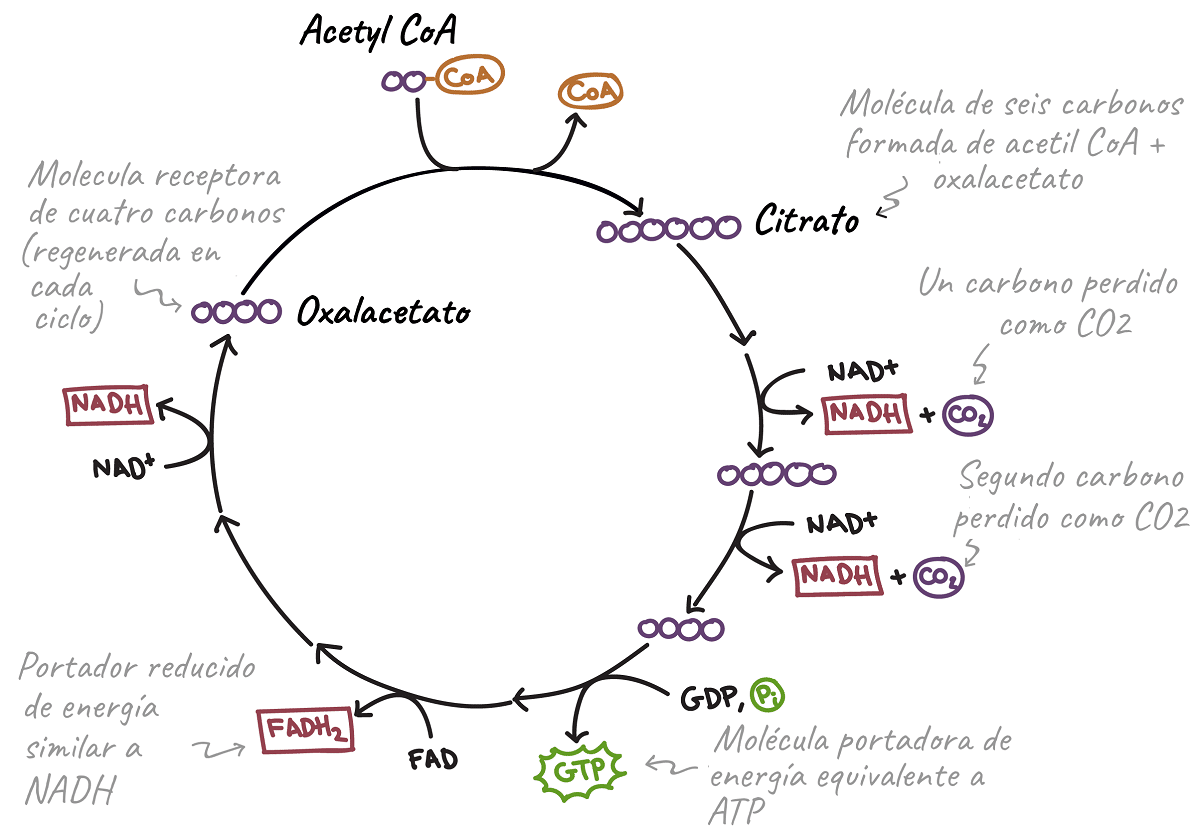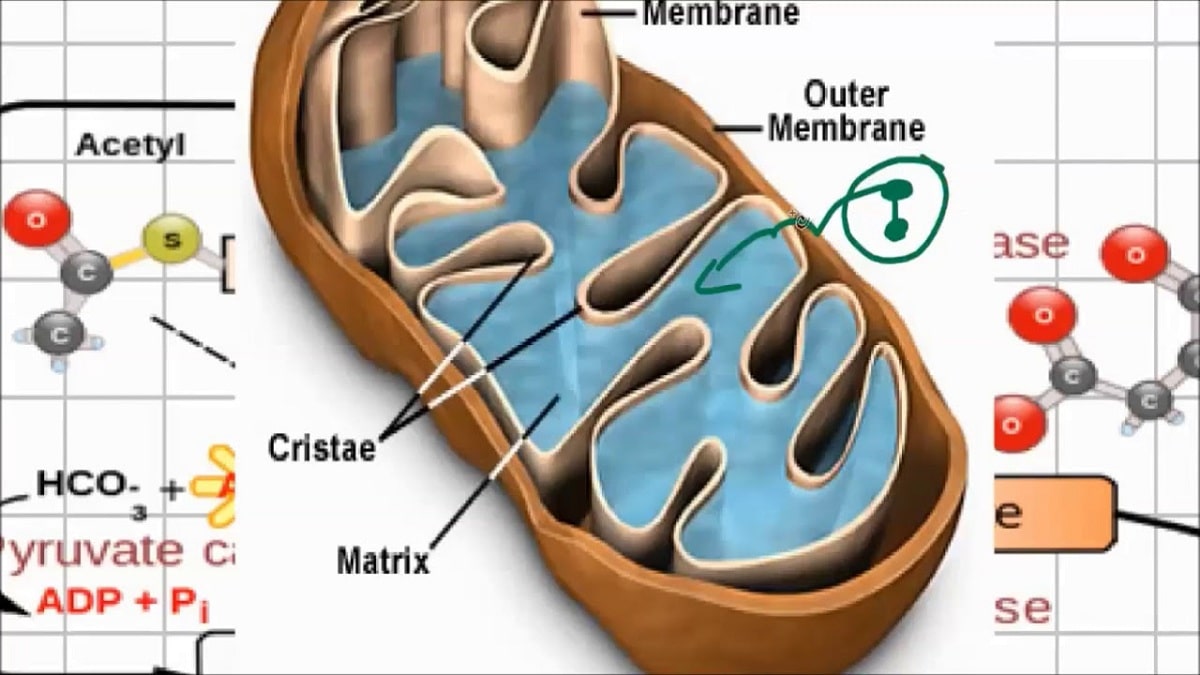
Whether you have studied biology in high school, or are reading about muscle mass gains, you have surely heard of the Krebs cycle. It is one of the metabolic stages of aerobic cellular respiration that takes place in our body. It is also known by the name of the citric acid cycle and is a metabolic stage that takes place in the mitochondrial matrix of all animal cells.
In this article we are going to tell you what the characteristics are, step by step the parts of the krebs cycle and their importance at a general level.
Phases of cellular respiration

Before we can explain what the krebs cycle is, we must remember how cellular respiration works, since it is of vital importance. Let's see what are the phases of cellular respiration. It happens in 3 main phases:
- Glycolysis: it is the process by which glucose is broken down into smaller parts. During this process pyruvate or pyruvic acid is formed which will lead to Acetyl-CoA.
- Krebs cycle: In the Krebs cycle, Acetyl-CoA is oxidized to CO2.
- Respiratory chain: Here most of the energy is produced by the transfer of electrons from hydrogen. This energy arises from the elimination of the participating substances in all the previous steps.
What is the krebs cycle

How cellular respiration works, which is included in one of the steps of this cycle, let's see what it is about. We know that it is a complex cycle and it has numerous functions that aid cellular metabolism. Without this cycle, all cells could not fulfill functions that are vital for our body. The final objective of the krebs cycle is to be able to promote the breakdown of the final products of metabolism of carbohydrates, lipids and some amino acids.
When we eat food we must know that the main macronutrients are carbohydrates, proteins and fats. Proteins are, in turn, made up of amino acids. For this reason, in the feeding process the krebs cycle is of great importance. All substances that are ingested into the body through food become in Acetyl-CoA with the release of CO2 and H2O and synthesis of ATP.
Thanks to this synthesis, it is where the energy that the cells must use in order to fulfill their functions is generated. We have various intermediates throughout all the stages of the cycle that they use as precursors in the synthesis of amino acids and other biomolecules. Thanks to this cycle we can obtain energy from the molecules of organic food. This energy that we obtain we can transfer it to the molecules for use in cellular activities and we can carry out our vital functions and all the physical activities of our day to day.
Within the krebs cycle we find some chemical reactions that they are mainly oxidative in nature. All reactions need oxygen in order to take place. Each chemical reaction has the participation of some enzymes found in the mitochondria of cells. All enzymes have the main characteristic of being able to catalyze chemical reactions. When we talk about catalyzing a reaction we are referring to being able to increase the rate at which reactants are converted into products.
Steps of the krebs cycle

There are several chemical reactions during this cycle that require oxygen to be carried out. The first chemical reaction is the oxidative decarboxylation of pyruvate. In this reaction, the glucose obtained from the degradation of bald hydrates is converted into two molecules of pyruvic acid or pyruvate. Glucose is degraded through Glycolysis and becomes an important source of Acetyl-CoA. The oxidative decarboxylation of pyruvate begins with the citric acid cycle. This chemical reaction corresponds to the elimination of carbon dioxide and pyruvate that is generated in the acetyl group that binds to coenzyme A. In this chemical reaction, NADH is produced as an energy-carrying molecule.
Once the Acetyl-CoA molecule has been formed, this is when the kreb cycle takes place in the matrix of the mitochondria. The objective of this part is to be able to integrate a cellular oxidation chain to oxidize all the carbons and to be able to convert them into carbon dioxide. For all these chemical reactions to take place, the presence of oxygen is necessary at all times. Thus, We mentioned before beginning to describe the Krebs cycle the importance of cellular respiration.
It all begins with the enzyme citrate synthetase that serves to catalyze the chemical reaction in which the transfer of the Acetyl group to the oxaloacetic acid that forms citric acid acts and the release of coenzyme A. The name of this cycle is related to the formation of citric acid and all the chemical reactions that take place here.
Further oxidation and decarboxylation reactions occur in the following steps. These reactions cause ketoglutaric acid to form. During the process, carbon dioxide is released and NADH and H are formed. This ketoglutaric acid undergoes an oxidative decarboxylation reaction that is catalyzed with an enzymatic complex of which Acetyl CoA and NAD are part. All these reactions will lead to succinic acid, NADH, and a GTP molecule that will subsequently transfer its energy to an ADP molecule producing ATP.
The last steps of this cycle so they only focus on the fact that succinic acid can be oxidized to form fumaric acid. This type of acid is known by the name of fumarate. Its coenzyme is ADF. Here FADH2 is going to be formed, which is another energy carrier molecule. Finally, fumaric acid is unpleasant to be able to form malic acid also known as malate. To end the cycle of krebs, Malic acid begins to oxidize to gradually form oxaloacetic acid. In this way, the cycle is restarted and again all the reactions that we have mentioned happen again from the beginning.
I hope that with this information you can learn more about the krebs cycle and its characteristics.